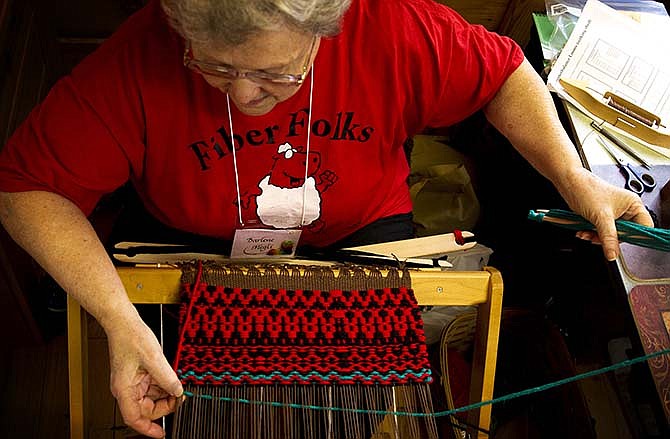This year's Fiber Retreat attracted so many people they had to hold it in two places.
Lincoln University's Carver and Busby Farms played host to the retreat, an annual festival that attracts people from throughout the Midwest, to learn more about knitting, weaving, spinning, crocheting, making dyes and soap, caning chairs and even basket weaving.
The annual Mid-Missouri Fiber Retreat is assembled by the LU and University of Missouri Cooperative Extension programs, in cooperation with the Fiber Guilds of Missouri.
Its theme, and focus, was: "Preserving the past for the enrichment of the future."
What's the attraction?
"The creating, I suppose," said Darlene Megli, of Lamar, who's been weaving for 26 years. "If you're a touchy-feely person - you've got the yarns and the fibers and they all feel different and they all feel wonderful."
Linda Arment, of Wyandotte, Oklahoma, lives about a mile west of the Missouri border and crosses the state line regularly to work with members of the Southwest Missouri weavers guild.
"It's a tactile thing," Arment explained. "I get a sense of satisfaction. I just like to make things to give to my family and friends.
"It's just cathartic."
They were two of the 20 participants taking the "Boundweave or Weft-Faced Twill" class with Tom Knisely, a full-time weaver who lives and works near Harrisburg, Pennsylvania.
With 38 years experience, he knows weaving is not a dying art.
"I've got 20 people here today who are loving everything that they're doing with it," he said, taking a break from consulting with each of the participants about their individual projects.
He quipped, "It's just that you don't find weavers as frequently as you might find other people with other hobbies.
"You'll find a lot more golfers than you'll find weavers."
While Megli and Arment talked about the feel of the fibers as they merged individual strands of colored yarn into a pattern, Knisely said he first was attracted to weaving by "the mathematics of it and I like the architecture. When I was a kid, I wanted to be either an architect or an archaeologist, because I liked history.
"This incorporates both, because this has such a long history, as far as textiles, for clothing ourselves or furnishing our homes with rugs and carpets."
Also, at least for weavers - and, perhaps, many of the other fiber artists gathered for the festival - the tools used today are modern, but the skills often go back years.
Or centuries.
For the craft folk, it's not assembly line-type machines.
"These folks are threading their looms by hand," Knisely said. "They're choosing the colors that they want to use.
"But they are, actually, physically weaving every inch of this fabric, all by hand."
Jeff Reynolds, of Marshall, has been weaving for 21 years and teaches some of the beginning classes.
"My attraction was colonial coverlets - the antique coverlets that our ancestors did in the 1700s and 1800s that drew me in," Reynolds explained. "That's why I learned to weave - and then I had to learn enough to share with others."
However, weaving is more expensive than some of the other crafts explored during the Fiber Retreat because the looms are complicated and, therefore, not cheap.
"You can find a loom for about $300, used," Reynolds said. "You can go all the way up to $5,000 or $6,000 for a loom.
"It takes a lot of weaving to pay for a $5,000 loom."
Megli, who gets some of her fibers from the sheep and alpaca she raises, also has a small business that sells "wheels and looms and fibers and stuff."
She agreed it isn't the best hobby or craft financially.
Still, Megli said, "There are a lot of inexpensive looms that you can get for less than $200.
"And you can, actually, make a loom out of wood and nails."
If you get hooked, Knisely noted, some of the high-end looms "are computer-interfaced."
Several acknowledged some think weaving is a dying art, but more and more young people are being attracted to it.
They each had the same advice for someone curious about starting out: Take a class.
"Take a basic weaving class, to find out if you really like this, because you'll have looms available to you," Knisely said.

